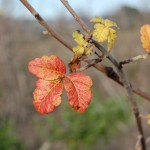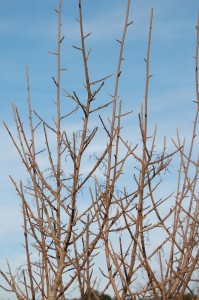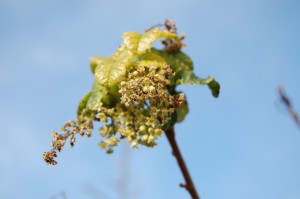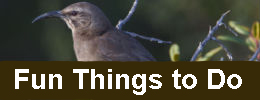 Poison oak! Does your skin itch at the very thought of this common plant? If you’ve ever accidentally brushed up against poison oak and developed a skin rash, you know how uncomfortable that can be. So, what’s the good of poison oak? Can’t we just get rid of it once and for all?
Poison oak! Does your skin itch at the very thought of this common plant? If you’ve ever accidentally brushed up against poison oak and developed a skin rash, you know how uncomfortable that can be. So, what’s the good of poison oak? Can’t we just get rid of it once and for all?
Well, no, we can’t. It’s such an essential part of much of the vegetation in California and so entwined with the lives of some species of wildlife, that we can’t get rid of it. Nor should we. Poison oak benefits the lives of many different kinds of wildlife.
But first let’s look at some of the characteristics of the plant. Toxicodendron diversilobum (“poison tree with varied leaves”) is native to California and occurs from British Columbia to Baja. You won’t find it in the desert or over 5000 foot elevations in the mountains, but you will find it in chaparral–whether it’s along the coast or in the foothills of the Sierra Nevada or the Cascades, in oak woodlands, or in grasslands. Poison oak is a generalist in terms of its habitat requirements.
The famous phrase, “leaves of three, let it be,” refers to the fact that the leaves of poison oak occur in groups of threes. And the leaves themselves do look oak-like with scalloped edges. In the spring when poison oak leafs out, the leaves are first maroon, turning dark green and shiny. The flowers of poison oak are inconspicuous in loose clusters, appearing in summer followed by greenish white berries.
 As the fall approaches, the leaves turn yellow and red as the chlorophyll (the green pigment) disappears from the leaves and back into the stems of the plant. These beautiful colors are other plant pigments: carotenes and anthocyanins. In late fall, the stems of poison oak are mostly a dull bare brown.
As the fall approaches, the leaves turn yellow and red as the chlorophyll (the green pigment) disappears from the leaves and back into the stems of the plant. These beautiful colors are other plant pigments: carotenes and anthocyanins. In late fall, the stems of poison oak are mostly a dull bare brown.
Berries can still be present, and oil on the stems can cause a rash. Poison oak is a dioecious species, having both male and female plants. It can grow as a vine climbing up trees or as a shrub nearly the size of a small tree.
Studies done by the US Fish and Wildlife Service found that poison oak was one of the top food plants for wildlife in the western states. Deer browse the stems, leaves, and branches, and the berries are a choice food for birds. In Knowland Park, you can see birds clinging to the branches feeding on the berries. Deep in the tangle of chaparral or coastal scrub thickets, wrentits depend heavily on the berries for food. When birds digest the berries and excrete the seeds, they help spread the plant.
 Learning to live with poison oak is just part of being out in the wild, so it’s good to know how to protect yourself from getting a dose of the toxic oil (urushiol) on your skin. Wear long sleeves and long pants. Be mindful as you travel through brush of what you touch, including overhead. If you’ve been through brush, it’s a good idea to change clothes as soon as possible, including your shoes, and shower in cool water. The oil can remain on shoelaces, so remember to wash your hands after you tie your shoes. If you know you’ve brushed against poison oak, you can use the product Technu, even if you’ve already developed a rash. If you’ve walked your dog off-leash and off-trail in the park, it’s likely that your dog has brushed up against poison oak since it’s found in every vegetation type in the park.
Learning to live with poison oak is just part of being out in the wild, so it’s good to know how to protect yourself from getting a dose of the toxic oil (urushiol) on your skin. Wear long sleeves and long pants. Be mindful as you travel through brush of what you touch, including overhead. If you’ve been through brush, it’s a good idea to change clothes as soon as possible, including your shoes, and shower in cool water. The oil can remain on shoelaces, so remember to wash your hands after you tie your shoes. If you know you’ve brushed against poison oak, you can use the product Technu, even if you’ve already developed a rash. If you’ve walked your dog off-leash and off-trail in the park, it’s likely that your dog has brushed up against poison oak since it’s found in every vegetation type in the park.
 Laura Baker is an environmental activist and former Conservation Chair of the California Native Plant Society. Growing up in Missouri, she learned that the cure for most ills rests in spending time out in nature. She wishes for every child to have the experience of wholeness that nature provides. Laura holds an M.A. in Ecology and Systematic Biology.
Laura Baker is an environmental activist and former Conservation Chair of the California Native Plant Society. Growing up in Missouri, she learned that the cure for most ills rests in spending time out in nature. She wishes for every child to have the experience of wholeness that nature provides. Laura holds an M.A. in Ecology and Systematic Biology.
Laura’s Knowlander blog is dedicated to building an online library of the natural history of Knowland Park so that the public may enjoy the park for the natural heritage treasure that it is. Knowing the land is a never ending process of inquiry open to all. We welcome your comments, contributions, and photos.
 Follow
Follow








Comments are closed.